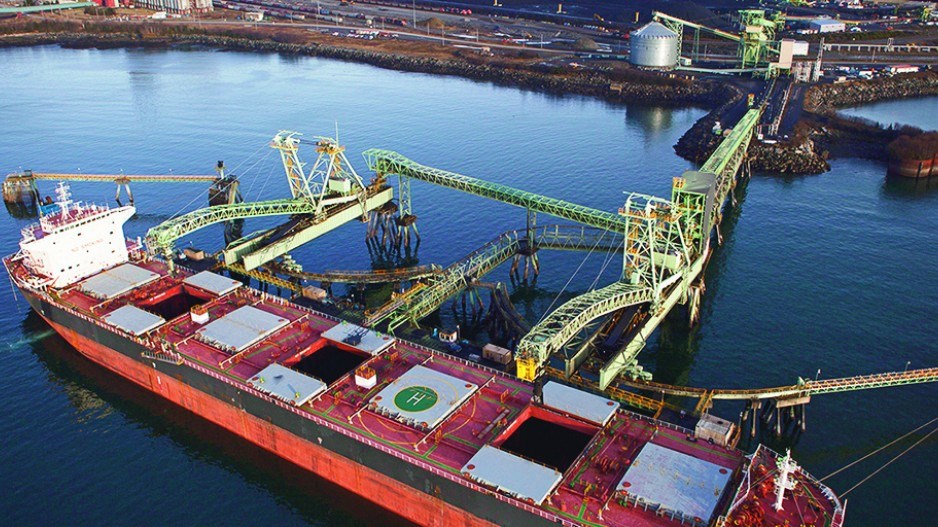As the Port of Prince Rupert gains global cargo momentum through another expansion, there is growing recognition that the northern port and the Port of Vancouver must collaborate to maximize Canada’s Asia-Pacific Gateway trade potential.
The revelation was underscored on Nov. 16, when Ottawa announced $75 million in funding for a second berth at Prince Rupert’s Trigon Pacific Terminals’ bulk cargo facility.
The $163.1 million project will expand not only Prince Rupert’s ability to handle its traditional top commodity, coal, but also allow it to shift towards greener energy exports like wood pellets and – more likely – ammonia as a carrier for hydrogen.
On the same day, Robin Silvester, the Vancouver Fraser Port Authority’s president and CEO, delivered his annual presentation to the Greater Vancouver Board of Trade. He revealed that the experience of last winter – when atmospheric river flooding washed out almost all rail and road links to the Port of Vancouver – re-enforced his belief that Canada’s two Pacific ports must collaborate to overcome ongoing supply-chain challenges.
An expansion to Trigon Pacific Terminals’ facilities is another example of Prince Rupert’s growing capacity to handle more cargo and its ability to help answer shipping demands on Canada’s Pacific front in conjunction with Vancouver.
“If you look at the West Coast of Canada, there really are just two gateways where goods can get to markets around the world,” Silvester said. “Canada’s trade future to the west – where you find the largest and fastest-growing economies in the world – is going to depend on those two gateways.
“Yes, we operate separately... at arm’s length of each other. But we also sit under the same structure, we see the same issues, and we have the ability to look at the future in much the same way. So I would say there is a lot of good collaboration, in particular around things like supply-chain optimization.”
Prince Rupert provided some relief during the Port of Vancouver’s flood-challenged logjam last winter, and the northern port’s importance is now further highlighted in the federal funding announcement for Trigon’s second berth, said Prince Rupert Port Authority president and CEO Shaun Stevenson.
“Today, there is in excess of $60 billion worth of trade that’s anchored through the Port of Prince Rupert,” Stevenson said during the federal announcement. “Investment like this in terminals like Trigon Pacific recognizes the strategic importance of the importance of the Port of Prince Rupert for the future.”
Prince Rupert’s advantages as a major port have never been a secret. It has a deep natural harbour and is geographically closer to major Asian ports like Tokyo and Seoul than other West Coast North American ports. Prince Rupert also has available industrial land and expansion space, as well as links to the CN Rail (TSX:CNR) network with quick access to central U.S. cargo hubs like Chicago.
During the Port of Vancouver’s controversial bid to build the $3.5 billion Roberts Bank Terminal 2 container facility expansion, many opponents brought up Prince Rupert as an alternative, less environmentally sensitive location for an expansion.
However, rail industry experts also point out that Prince Rupert’s limited ecosystem for bigger shipping operations that is readily available in Vancouver and the small population along its northern rail corridor limit its long-term growth potential.
As of 2021, Vancouver remains by far Canada’s largest port in terms of total cargo tonnage handled (146 million tonnes). Prince Rupert, meanwhile, placed third with 25 million tonnes during the same period. Montreal was sandwiched in between (34 million tonnes).
That’s why, said Trigon CEO Rob Booker, the new Berth 2 at Prince Rupert’s bulk-cargo facility slated to open in 2026 is so important. It offers the opportunity to build that ecosystem to support more shipping demand. Booker noted that Trigon has been exploring shipping hydrogen-as-ammonia as a future commodity – especially since markets like South Korea have placed a high emphasis on using hydrogen as a clean, renewable fuel.
Meanwhile, providing a port to export ammonia allows for producers in Western Canada to start connecting the dots and create the supply chain between producers, the port and Asia.
Booker said that CN Rail’s August memorandum of understanding with Alberta-based Keyera Corp. (TSX:KEY) to create a clean-energy terminal would be a prime example of a partner that could eventually feed into Trigon Pacific.
“They [stakeholders] will now see that Canada has the infrastructure to do this,” Booker said. “Now we can connect them ... going from someone building a facility to produce hydrogen-as-ammonia or other hydrogen products for export to having our terminal. After that, you now could have the business case to build the land-side facilities that are needed.”




